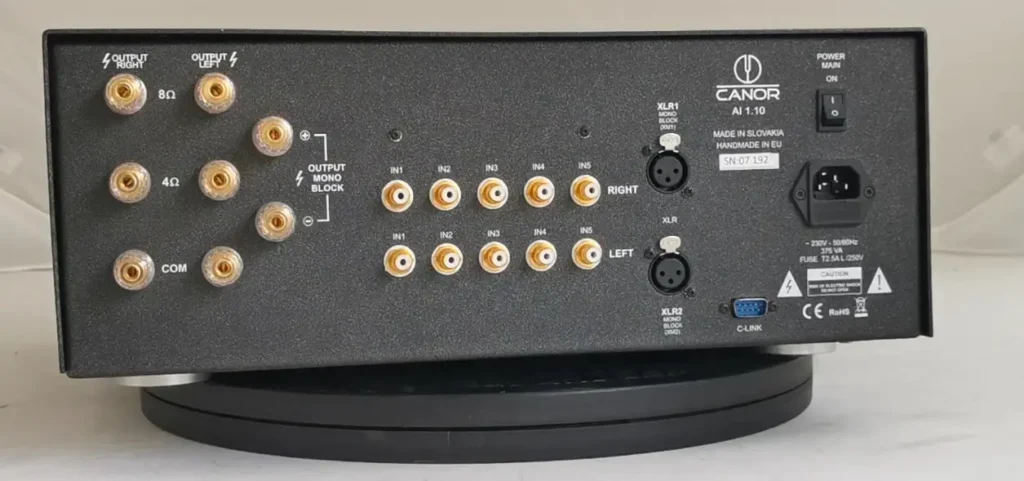Canor AI 1.10 Review: it couldn’t be better
So clean and neutral that you almost forget you’re listening to a tube amp: With the Canor AI 1.10, Canor has created a timeless classic amplifier that transcends genre boundaries.
Canor AI 1.10 Review: We had long planned to test the Canor AI 1.10, and the wait has been worth it. My first encounter with both the devices and the passionate team behind them was at High End 2024—a time before the pandemic when no masks hid the broad smiles brought on by exceptional audio experiences. One standout moment was hearing the Finkteam system, masterfully designed by Karl-Heinz Fink. Practically everyone who sat in the acoustically optimized demo room couldn’t help but smile, thanks to the incredible synergy. Naturally, the in-house Borg loudspeakers were part of the equation, delivering stunning sound clarity.
Check Out: Canor Hyperion P1 + Virtus M1 Review: preamp/power amp
And then there was this beautiful electronics from Slovakia, which I only knew before by its name, which also appeared now and then on the boards of the Austrian rational high-end giant Pro-Ject.

Indeed, the Canor plant in Prešov, Slovakia, builds large parts of the Pro-Ject electronics but also serves other OEM customers. This makes good use of the capacities of the approximately 80 employees and is certainly responsible for the deliberately calm market launch of the private label: I have rarely heard so little marketing hubris from a company that is so clearly targeting the audiophile premium market.
No one is in a particular hurry or wants to suddenly dominate the market for this or that niche product. Testers love this trick. Here, you still get the feeling of having discovered something great yourself. In any case, the test devices were scarce at first, but then other things intervened, such as the two outstanding PH 2.10 and PH 1.10 phono stages. And now the AI 1.10, which I wanted most urgently at the beginning, is finally appearing.
The special features of the Canor AI 1.10
What made the 1.10 so particularly attractive? In addition to the outstanding sound that it unfolded at the high end at the time, the prospect of a universal, reliable tube-integrated amplifier that you can blame for almost any speaker. The friendly Canor developer I spoke to at the trade fair (and whose business card I can no longer find) already pointed this out:
The AI 1.10 was not supposed to be a noble bitch that works fantastically with exactly three loudspeaker models in the world (but two of which are no longer built). It is a truly universal tube amp, with sufficient power but also sufficiently low output resistance to be able to drive real boxes with their mostly complex load behavior dynamically and tonally balanced.
The AI 1.10 not only met the ambitious goal in the Review but far exceeded it: It gets a sound out of a set of ordinary tubes that you don’t want to compare anymore. A sound that rests so perfectly in itself that other amps are no longer really of interest. You can also make friends with the optics: The AI 1.10 looks like all other Canors, so very, very good. Especially in silver, I think. But also in black, think others. In any case, the sales department sells almost the same amount of both variants.

The design is simple, the realization very refined, but not at all ostentatious-vulgar: the silver front panel has a certain thickness, and this allows a slightly recessed mounting of the central volume button, which seems to emerge from a soft amber glowing halo. Out of respect for this, even the continuous black acrylic band makes a celebratory arc, which in turn bears the amber-colored illuminated company logo. To the right of this is a giant dot matrix display with a perfectly matching color, which is visible from afar but, at the same time, shows the selected input and the current volume with very little electrical interference.
Anyone who finds the amount of light disturbing can dim everything together in several stages up to a complete blackout. The AI 1.10 then flashes briefly to acknowledge the front panel or remote control commands. Except for triode ultra-linear switching, all functions are accessible remotely and directly on the device. There are not many: volume, muting, and the selection of the five high-level inputs, which takes place via high-quality, permanently contact-safe relays.
Volume control is also implemented with relays. When fully turned up, the display shows 0 dB. The passive preamp cannot increase the signal, but this is never necessary with sources of normal volume. It only gets tight with very clumsy combinations: If you operate an extra-quiet MC in the turntable, you should make sure that the phono preamp has sufficient gain, for example.
Not only is the input selection technically implemented, but also the volume control with high-quality, contact-safe relays. Depending on the desired weakening of the input signal, the relay signal box combines exactly the right selection of precision resistors to a total of 64 one-decibel steps. If you turn the play-free ball-bearing volume knob or press the corresponding buttons on the remote control, you will not only reap a change in level but also a lively click, which betrays the technical luxury solution.
Their advantages include perfect channel synchronicity today as in 20 years, the lowest possible distortion, and pleasant side effects such as the problem-free synchronization of several identical amps – we’ll see in a moment what this is for. A balance control would have been desirable and technically feasible without any problems. However, the available 1dB levels would have been quite rough for this.
After input selection and volume control comes the active part of the amplifier – completely tube-equipped: A double triode of the type 12AX7 plays the input stage, and two further double triodes – now the lower-impedance, but less amplifying 12AT7 – serve as drivers. A pair of KT88 beam tetrodes is responsible for power amplification per channel.
It doesn’t get much more ordinary than this selection of tubes – which is thoroughly positive news about a future exchange: these types are available in good quality from all corners of the world. For example, at the JJ company in Canor’s home country and EU member Slovakia.

However, Canor is exemplary in ensuring that such an exchange does not become necessary ahead of time. And even goes one step further: the Canor amps make their owners forget what technology they are listening with. With the 1.10, you can only see the end tubes smoldering through the ventilation slots in the thick sheet steel cover.
The double triodes are practically invisible because they are hidden in protective aluminum cylinders. In day-to-day use, only indications such as the half-minute warm-up after switching it on and the separate 4Ω and 8Ω speaker terminals remind us of the thermionic amplification. In the test, however, the 1.10 was completely free of any telltale extravagances: no crackling, no ringing, no hissing or humming, neither when switching on nor off, and certainly not when listening to music.
After my experience with three previous Canor models, I had expected nothing less. Because quality assurance during production is 110 percent. All tubes have to be burned in for 48 hours before they can be used, and then they go into Canor’s test system called Aladdin. Aladdin measures more different parameters than usual tube testers and stores the results of each tube in a database, which enormously accelerates and facilitates both the selection of components for new construction and later replacement.
You May Like: Naim Uniti Nova Review
The output stage of the AI 1.10 runs in class A, i.e., with such a high quiescent current that no crossover distortion can occur between the push-pull halves. Since tube amps already get quite warm in AB mode, the difference to pure Class A is no longer as obvious as with their transistor colleagues: The AI 1.10 just gets a little warmer and, at 420 watts, draws a little more power from the Can than other typical KT88 push-pull. You get 40 watts per channel from your energy input from the AI 1.10. Thanks to the adapted transformer tappings, this power is equally available on 4Ω and 8Ω boxes.
If you use high-efficiency loudspeakers with the Canor, you can control the output tetrodes like triodes at the push of a button, i.e., put your screen grid on the potential of the anode. Then the whole thing is no longer amplified so well, the power is halved, and you get an even nicer distortion spectrum that is exclusively occupied by even-numbered harmonics. Switching is only possible directly on the device and should take place during music breaks and not too quickly back and forth.
You don’t have to compare for long anyway, because the advantages and disadvantages of the two modes are crystal clear due to the enormous basic quality of the amp: “Triode” sounds very warm and gentle, “Ultralinear” is spatially wider, more lively, and the bass is much better defined. The ultra-linear operating mode connects the screen grid of the tube with a precisely defined center tap of the output transformer and thus represents a type of local negative feedback – with correspondingly favorable effects on output resistance and distortion level.
So, with Ultralinear, there is more power, more control, and less distortion. One might ask why a switch is necessary at all – which is not only available from Canor but also, for example, from tube amps from Cayin or Line Magnetic. You ask yourself that question until you have tried the two modes with different speakers. It then primarily depends on the efficiency and impedance curve of the speaker: “Tube-friendly” constructions with rather high efficiency and high/linear impedance often sound better in triode mode. As expected, heavier loads often prefer ultra-linear – although taste and listening situation, as well as the design of the respective amplifier, also play a major role.
My Tannoy Legacy Eaton (89dB per watt/meter, 6Ω) is somewhat erratic when it comes to triode mode: I preferred it on many amps tested, but not all. Then there are those tube amplifiers that are not capable of anything else because they are simply built with triodes. Here, too, some specimens are fun on the Tannoy (such as the Line Magnetic 805) – and those that want more accommodation.
The Canor AI 1.10 is unusual in several respects: It sounds better on the Tannoys in ultra-linear mode. And it is not – as usual – a compromise where advantages and disadvantages then add up in favor of one or the other operating mode. The Canor required no compromises. It just sounded so good on the Eatons in every way
The “Output Mono Block” pair of terminals next to it is internally connected to the 4Ω windings of both output transformers, putting the amp in mono bridge operation. The Canor then receives the required symmetrical signal via one of the two XLR inputs. The blue SubD socket on the bottom right synchronizes the amp in mono mode with a second A 1.10.
hearing test Canor AI 1.10 review
Dynamics and scale are two parameters that are closely related: How wide does the window through which we view the music open? When Canor: huge. The answer has surprisingly little to do with an amp’s spec sheet performance. In this point, there are parallels to the Pass INT-25, which also works in Class A and is specified as only 25 watts at 8Ω – but in practice and at lower impedances, it can deliver a multiple of this power.
The Canor delivers an unspectacular 40 watts per channel but develops it so completely effortlessly and casually that even close to the limit, there is not a hint of effort. Even if the physical limits of the tubes used are simply reached beyond those 40 watts, it seems even more dynamic in a direct music comparison to the pass. Some records need that. Low’s current LP, for example, ends in the seven-minute track “The Price You Pay”.
As is typical for Low, the piece begins with the tender, two-part singing of the Sparhawk and Parker couple. After listening to the album, one has already gone through a lot at this point and gratefully lets oneself fall into these wonderful, simple harmonies. And then these edgy, distorted beats stomp into the piece again, piling up higher and higher to a true “WTF??” moment:
If you don’t counteract this with the volume control early on, you can hardly do it on your own from minute three of the button. And wonders how the hell this piece was able to escalate like this. And it just escalates with the Canor even more immediately, surprisingly, more frighteningly than with the Pass – which is not just any random amp, but the best solid-state integrated amplifier that I know of.
If a particularly large amount of power is required, for example, for heavy-duty loudspeakers in corresponding rooms, you can convert the AI 1.10 into a monoblock and buy a second 1.10. The two amps then each run in a bridge circuit and synchronize their volume control via a control cable.
Karl-Heinz Fink had the 1.10 running at the High End back then. So, two of them. For trade fair conditions – huge room, massive acoustic measures, background noise, correspondingly high demonstration volumes – an ideal setup with a smooth 80 watts per channel will probably only rarely be necessary at home. In any case, it’s good to know that the option is always available.
timbres and neutrality Canor AI 1.10
The Canor gains tonal diversity and intensity not so much through its own efforts but through an unusually neutral approach for tube conditions. In the listening room, my old Linn LP12 / Lingo 2 / Kore / Ekos 1 played upstream with a brand new Thorens TAS 1600 scanning fantastically clean and nuanced.

The color palette that the combined masterminds deliver to the Canor is opulent, and it shines through the amp virtually unhindered. Where other tubes swallow a bit of differentiation at the top, underline the presence range a little, or slim down the basic tone by a few grams, i.e., leave a touch of their sound, the Canor blooms with pure, fragrant, unfiltered nature.
Reproducing colors unambiguously and with rich nuances: the Canor does this better than any other integrated amplifier that has ever stood in my listening room. “Ich Tauche Auf” from the current Tocotronic double LP “Nie Wieder Krieg” sounds delicate; the voices of Tocotronic singer Dirk von Lowtzow and guest singer Soap&Skin are so close that you can feel their breath on your skin.
On the rough, leathery opposite side of the tonal color spectrum there are records like “Bubblegum” by the late Mark Lanegan: Recorded in the legendary and anecdotal desert studio Rancho de la Luna in Joshua Tree, California, staffed by top-class stoner rock personnel, such as the practically entire Queens Of The Stone Age, guitarist/studio operator David Catching and Masters Of Reality boss Chris Goss, as well as illustrious guests like PJ Harvey, who performs an enchanting duet with Lanegan on “Come To Me”.
With the Canor, that sounds exactly as it should: authentic, direct, and highly dynamic. You can hear the wooden walls resonating, see the grains of desert sand dancing on the vibrating floorboards, feel the pressure of Josh Homme’s bass amp in your stomach, and witness two huge and opposite rock voices ensnare each other: Lanegan’s distressed, tequila-soaked baritone and Harvey’s ethereal soprano. Unrepeatably grandiose, and with the Canor and Tannoys, you feel like you’re standing right next to it. Not a coffee cup in hand, but a glass of José Cuervo.
Details Canor AI 1.10
The Canor AI 1.10 has an extremely fine resolution but remains completely informal. A rare combination of tonal beauty and complexity, and an extremely desirable one, because the extra information that the amp conjures up in the listening room never comes across as forced, intrusive, or artificially cymbal. Christy Moore’s “Live – At The Point” once again has a big “Wow!” in the listening test notes: voice and guitar as stable as nailed down, accurately differentiated from listening around, but still with completely smooth edges.
Authority with silk gloves, from which the light, playful, and spontaneous in Moore’s announcements and anecdotes benefit enormously, the sparkling energy that connects the singer with his live audience like a high-voltage line. This atmosphere lives from the finest details, which can get caught in many places on their way from the vinyl groove to the speaker. Here, they don’t. And a lot of what I previously chalked up to the speaker or pickup simply dissolved in pleasure.
Conclusion Canon AI 1.10
One can philosophize about how Canor manages to make the AI 1.10 sound so incredibly open and neutral. Is it the house-wound noble transformer built with a precisely balanced core composition (30% permalloy)? Circuit boards (CMT, Canor Milling Technology) are artistically skeletonized by CNC milling, which is supposed to combine the advantages of circuit boards and free wiring.
Or just a lot of experience, sophisticated circuit design, and a bit of luck? In any case, for the price of this amp, I don’t know of anything better, nicer, or more uncomplicated. The key data – KT88, 40 watts – are much cheaper. But they don’t tell the whole story. Not even a chapter of it.
Canon AI 1.10 Specifications
Technical concept: Tube Integrated Amplifier
Performance: 2 x 40 watts (ultra-linear), 2 x 20 watts (triode)
Inputs: 5 x RCA
used tubes: 1x12AX7, 2x12AT7, 4xKT88
Particularities: Power amp mono bridgeable
Dimensions (W x H x D: 43.5×17.0x48.5cm
Weight: 26.0 kilos
FAQs about the Canor AI 1.10 Tube Amplifier
Q1: What type of amplifier is the Canor AI 1.10?
A1: The Canor AI 1.10 is a high-end integrated tube amplifier that uses vacuum tubes for amplification. It is designed for audiophiles seeking a warm, natural sound.
Q2: Which tubes does the Canor AI 1.10 use?
A2: It uses four KT88 output tubes and two 12AX7 input tubes. These tubes contribute to its rich and detailed sound quality.
Q3: What is the power output of the Canor AI 1.10?
A3: The amplifier delivers 40 watts per channel in a Class A/B configuration. This power output is sufficient for most home listening environments, especially with efficient speakers.
Q4: Is the Canor AI 1.10 compatible with all speaker types?
A4: While it can drive many speaker types, it works best with high-efficiency speakers, typically with a sensitivity rating above 88 dB.
Q5: Does the Canor AI 1.10 come with a remote control?
A5: Yes, the amplifier includes a remote control, allowing for easy adjustments to volume and input selection.
Q6: What kind of sound signature does the Canor AI 1.10 have?
A6: The AI 1.10 is known for its warm, full-bodied sound with excellent midrange detail and a smooth top end. It provides a natural presentation, typical of tube amplifiers.
Q7: Does the Canor AI 1.10 need a bias adjustment for its tubes?
A7: Yes, it includes a built-in automatic bias adjustment feature that simplifies tube maintenance and ensures optimal performance.
Q8: How long do the tubes in the Canor AI 1.10 last?
A8: Tube lifespan varies based on usage, but on average, KT88 tubes can last around 2,000-3,000 hours, while the 12AX7 tubes can last longer, around 5,000-10,000 hours.
Q9: Is tube rolling possible with the Canor AI 1.10?
A9: Yes, tube rolling is an option, and users can experiment with different tube brands or types to customize the sound.
Q10: Does the Canor AI 1.10 require regular maintenance?
A10: Tube amplifiers generally need more maintenance than solid-state amplifiers. You may need to replace tubes periodically and check the bias to keep them in optimal condition.
Pros of the Canor AI 1.10 Tube Amplifier
- Rich Sound Quality
- High Build Quality
- Automatic Bias Adjustment
- Remote Control
- Tube Rolling Capability
- Efficient Power Output
Cons of the Canor AI 1.10 Tube Amplifier
- Price
- Limited Power for Low-Sensitivity Speakers
- Fragility of Tubes
- A Little Warmup Time







